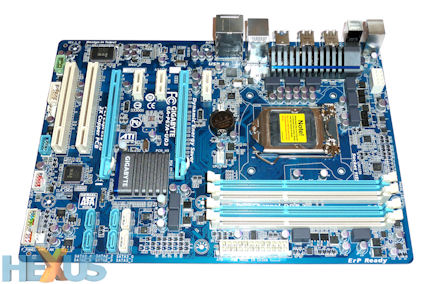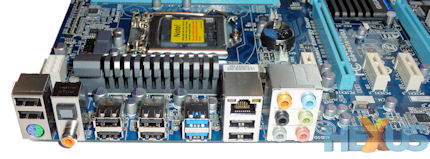Intel Sandy Bridge to act as sales catalyst
Motherboard manufacturers are waiting on Intel to release its Sandy Bridge CPUs, due for launch in January 2011. Intel is changing the socket for its mid-range chips from LGA1156 to LGA1155. This means that the new processors - which integrate practically all the core-logic into the silicon - will require supporting motherboards based on Intel 6-series chipsets. This is good news for manufacturers looking to ride the interest generated by the new wave of processors, as it enables them to release a glut of boards to market.
Now, manufacturing an LGA1155-compliant motherboard is old hat to an experienced partner. The change in socket and layout requires minimal re-tooling at the factory, and this is why the likes of Gigabyte, MSI, and ASUS have been champing at the bit to showcase their new boards. Heck, we saw non-working sample LGA1155 boards back at COMPUTEX 2010, held in May.
Intel is now allowing partners to showcase what the new generation of motherboard will provide in terms of features, but is prohibiting them from supplying the press with CPUs with which to run the usual array of benchmarks.
Gigabyte has been keen to extol the virtues of its upcoming line-up of Intel 6-series boards. To that end, the company sent us the mid-range GA-P67A-UD3 for our perusal. Full benchmarks to follow with the launch of the Sandy Bridge chips.
GA-P67A-UD3 scrutinised
Looking for mass-market appeal, the basic P67 range of boards will encompass three models: P67A-UD3, PH67A-UD3 and PH67-UD3 - designed to cater for slightly different markets. There will also be a revved-up 'R' model with more emphasis on cooling and style.
Presented in the now-familiar dark-blue PCB with blue-and-white ports, the P67A-UD3 is a reduced-size ATX-sized board that, given the smaller dimensions of 30cm x 21cm, is spaciously laid out. Components don't cramp one another, helped by the CPU not requiring a separate northbridge.
There's an abundance of room around the socket, and positioning a reference LGA1155 heatsink on top of the CPU socket highlights that Gigabyte retains decent access to the four DIMM slots on the right-hand side. The company says it will support dual-channel DDR3 memory at speeds of up to 2,133MHz, matching what's on offer with current LGA1156 (Lynnfield) boards.
The eight-pin board connector is located nicely out of the way and the left-hand heatsink should keep the hotter-running components cool under load, though our sample model's was rather loose and flimsy. Gigabyte throws in two 4-pin and two 3-pin fan headers; good enough to avail decent airflow.
The lack of a northbridge means Gigabyte has a lot of PCB real estate to play with. The P67 chipset requires only modest cooling, and the low-profile heatsink is sandwiched between the two mechanical x16 PCIe slots.
Intel Sandy Bridge CPUs integrate a x16 PCIe bus-link. This is used to power the primary (right-hand) PCIe slot that's used for graphics cards. The P67 chip's topology is such that, on this board, it provides the other full-length x16 slot with a x4 electrical interface, which drops down, via a built-in switch, to x1 if either of the two x1 PCIe slots - situated between the two x16 - are populated with an expansion card. A further x1 PCIe and two PCIc make up the board's complement of seven expansion slots.
So while the board supports AMD's CrossFireX multi-GPU in two-card mode, bandwidth limitations of the x4 slot may come into play at super-high resolutions and image-quality settings, where data transfers are most active. We're surprised that Gigabyte doesn't bifurcate the x16 link into two x8 in two-card mode; Intel enables it in the P67 chipset.
In terms of storage, P67 supports four SATA 3Gbps and two white-coloured SATA 6Gbps ports. Gigabyte doesn't feel the need to rotate them on the edge of the board, and such is the room here, that's no problem. Looking to the right, the firm's dual BIOS chips come into view, though this board doesn't support the rather tasty UEFI BIOS.
Cuts have to be made somewhere; out goes FireWire, eSATA, and any third-party controllers to boost the UD3's storage quotient. Intel is still dragging its heels on chipset-integrated support for USB 3.0. Gigabyte remedies this by including the popular NEC/Renesas USB 3.0 controller that sits on its own PCIe lane and provides two ports on the I/O section. We'd like to see a board-mounted port that connects to a front-mounted USB 3.0, rather than having to drag the cable to the I/O section, as would be the case if a chassis has a USB 3.0 port. ASUS is specifying such a connector with its P67 boards.
The rear panel houses eight USB 2.0 ports and the two aforementioned USB 3.0. Another four are available through board-connected brackets, of which two provide charging for USB-connected devices even when the board is switched off.
What should be clear is that the P-series chipset doesn't provide the necessary video outputs for the graphics component of the Intel Sandy Bridge chips; you will have to use a discrete card.
Audio comes by way of the Realtek ALC892 CODEC, used in a number of Gigabyte board in 2010, and provides both optical and coaxial S/PDIF outputs for hooking up with hi-fi gear. An HDMI connection would have been nice, opening up the way for transport of Dolby True HD and DTS HD Master Audio.
Summary
The transition between incumbent LGA1156 and upcoming LGA1155 will be an easy one for established motherboard manufacturers. Gigabyte's mid-range appeal rests with the GA-P67A-UD3 board that hooks-up Intel's Sandy Bridge CPU in sensible fashion. Layout is good and the board is chock-full of the Gigabyte goodies we've come to expect over the last year.
Readers looking to go out and purchase the new Sandy Bridge/P67 combo will need to understand that, in some ways, it is a backward step from present P55 boards, especially for enthusiasts. The new chips won't support user-defined overclocking on regular processors (non-K models, more precisely) and the PCIe lane arrangement isn't ideal for multi-GPU usage.
We guess the attractiveness of the GA-P67A-UD3 rests on the retail price it will arrive at. It really needs to come in at under £100 for it to be competitive, and we'll have to wait until January to see how it pans out.

















